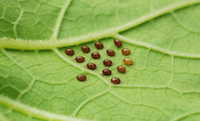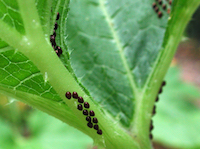Question: Back in April, I had questions about what turned out to be aphids on my peach trees. Now my melon plants are covered in squash bugs. Is there anything I can do to control them this late in the season?
Lorraine J., Los Lunas
Answer: I wish I had better news for gardeners with the squash bug blues. Squash bugs are difficult to control, and even more so as the bugs mature because insecticides are a much less effective tool.
Some people delay planting squash until July to avoid the squash bug, but this tactic is not foolproof. As many gardeners have reported this year, delayed planting seems to work some years, but not reliably.
 Squash bug eggs on the underside of a leaf. Photo credit Bdm25, Wikimedia Commons.Dr. Carol Sutherland, NMSU Extension Entomology Specialist and NMDA Entomologist, has suggested that you take a hint from their name and “squash” the squash bugs. Look for clusters of shiny orange-brown eggs on the underside of the lower leaves and smash them too. Sutherland also suggests that you handpick or scrape the bugs and their eggs from the plant into a can of soapy water. (I might use a large can or even a five-gallon bucket to save on repeated trips to dump and refill.) Manual removal is the most effective way for homeowners to manage this common garden pest at this stage. Manual removal is also the preferred control method earlier in the season, in addition to scouting for eggs and destroying them.
Squash bug eggs on the underside of a leaf. Photo credit Bdm25, Wikimedia Commons.Dr. Carol Sutherland, NMSU Extension Entomology Specialist and NMDA Entomologist, has suggested that you take a hint from their name and “squash” the squash bugs. Look for clusters of shiny orange-brown eggs on the underside of the lower leaves and smash them too. Sutherland also suggests that you handpick or scrape the bugs and their eggs from the plant into a can of soapy water. (I might use a large can or even a five-gallon bucket to save on repeated trips to dump and refill.) Manual removal is the most effective way for homeowners to manage this common garden pest at this stage. Manual removal is also the preferred control method earlier in the season, in addition to scouting for eggs and destroying them.
I know some readers are getting stressed thinking about collecting—and squashing—all of the bugs that are smothering their poor pumpkins right now. Our new NMSU Extension Integrated Pest Management (IPM) Specialist, Dr. Amanda Skidmore, shared a trick: “One way to get them to congregate is to put some newspaper, cardboard, or old boards near the base of the plant overnight. Squash bugs like to be in protected areas, especially when it starts to get cold at night. Check underneath in the morning and remove any squash bugs.” If you try this, please keep a body count each time and share your numbers with us via social media (@NMDesertBlooms and @NMSUIPM)!
 Clusters of squash bug eggs on leaves and stems. Photo credit Pollinator, Wikimedia Commons.As described in past columns on these pests written by Dr. Curtis Smith, “Dr. Sutherland explained that squash bugs are very strong flyers with a very good sense of smell. If they are in the area and they detect your squash, they will appear in your garden. This can happen any time during the summer… She explained that squash is not their only food supply. They feed on any cucurbit (squash, cucumber, ornamental gourds, and even native gourds). They do have favorite plants, and if they are feeding on native gourds and detect your squash, they will leave the gourds and infest your squash. If you choose to not plant squash for several years, this will not assure a year without squash bugs if these alternate hosts exist nearby, or if neighbors' gardens have been supporting squash bugs.”
Clusters of squash bug eggs on leaves and stems. Photo credit Pollinator, Wikimedia Commons.As described in past columns on these pests written by Dr. Curtis Smith, “Dr. Sutherland explained that squash bugs are very strong flyers with a very good sense of smell. If they are in the area and they detect your squash, they will appear in your garden. This can happen any time during the summer… She explained that squash is not their only food supply. They feed on any cucurbit (squash, cucumber, ornamental gourds, and even native gourds). They do have favorite plants, and if they are feeding on native gourds and detect your squash, they will leave the gourds and infest your squash. If you choose to not plant squash for several years, this will not assure a year without squash bugs if these alternate hosts exist nearby, or if neighbors' gardens have been supporting squash bugs.”
This is my third fall as the state Extension Horticulture Specialist and my third fall fielding late-season pleas for squash bug help. I promise next year to post frequent reminders, starting early in the season, to check under leaves for clusters of the shiny eggs when your cucurbits are still small and a little more manageable. Dr. Skidmore offered this idea to try next season, “One organic solution is to use kaolin clay as a deterrent. It’s a fine, white powder that’s mixed with water and sprayed onto plants. The clay is abrasive to the insect's exoskeleton and can impact their ability to feed. It does not contain any chemical insecticides, but can be irritating to the skin, eyes, and nose, so wear a mask and hand protection when handling it. It does wash away when it rains hard or when plants are watered from above, so it may need to be re-applied.” I worked with kaolin clay years ago on young pecan trees. The white, chalky clay coating made them look like frosted mini-trees.
We’ll revisit the recommended practices for using kaolin clay as an insect deterrent in the spring. For now, round up as many squash bugs as possible, enjoy your harvest as much as possible, and, as Dr. Skidmore warns, burn or throw away any remaining material from infested plants at the end of the season because squash bugs will overwinter in it, allowing them to get a leg up next year.
For more gardening information, including decades of archived Southwest Yard & Garden columns, visit the NMSU Extension Horticulture page (http://desertblooms.nmsu.edu/), follow us on social media (@NMDesertBlooms), or contact your County Extension office (https://aces.nmsu.edu/county).
Marisa Thompson, PhD, is the Extension Horticulture Specialist for New Mexico State University and is based at the Agricultural Science Center at Los Lunas.


